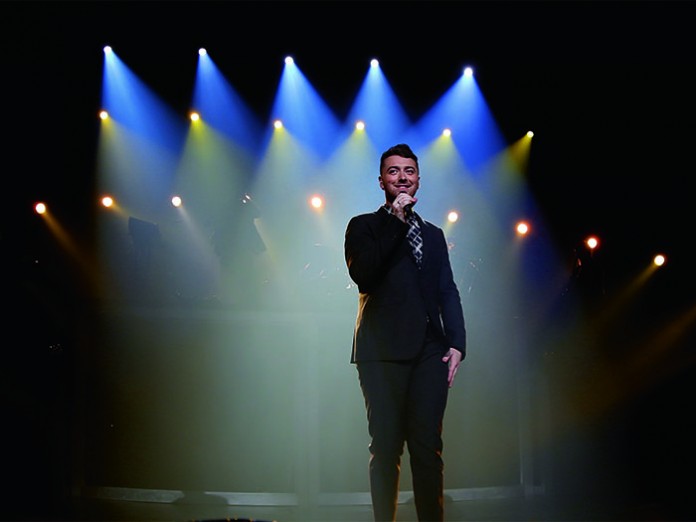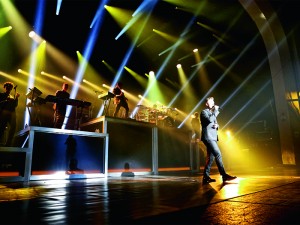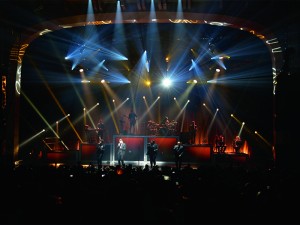In less than a year Sam Smith’s distinctive style and honest, personable approach to pop stardom has seem him rocket to fame. Singles from his debut album, In the Lonely Hour, regularly top the charts and, as his popularity has escalated, so too has the size of the venues that he can fill. In just six short months Smith has collected four Grammys and two Brit Awards. This public recognition has seen his tour visit a diverse mix of venues. To facilitate this, his creative team have had to respond quickly, adapting the stage design and scale of the show as they go. Sarah Rushton-Read spent a night with the incurably romantic at O2 Academy Brixton.
The great thing about touring with an artist on the fast track to fame is that, when they take off, it is an opportunity shared by all. Of course, it can also bring its own set of challenges. For example, busy Tour Manager Paul Allen found himself with an artist that now needs a great deal more protection from the media, Lighting and Production Designer Will Potts had a stage design that had to be up-scaled and downscaled on a daily basis, and Stage Manager James Gould has to find new ways to get an arena kabuki drop effect to work in a small theatre or bring a piano – that would normally come up on a lift – on and off stage, without looking clumsy. While all of this can be exciting, challenging and creatively inspiring, it can also be daunting. Luckily then, for Smith, the artist is accompanied by a seasoned team of touring professionals.
SHOW DESIGN
Potts’ design is classic and simple. His vibrant and sophisticated, tightly choreographed precision lighting resonates with Busby Berkeley-style geometric patterns, once fashioned from dancers to grand pianos! Part of Potts’ distinctive style is that he can programme lights to behave as if they have a mind of their own. On this occasion he delivers an extensive palette of richly-coloured, kaleidoscopic looks that transition with subtle ease from calm and simple to fast-moving and lavish.
The set comprises a number of risers that accommodate the band, backed by a curvaceous, variable height truss packed with Clay Paky Sharpy Wash 330’s. An overhead a rig of Philips Vari-Lite VL3000 Spots help to sculpt and give form to the various looks, while Clay Paky B-EYE K20’s project rich washes across the stage and provide an element of eye candy in the rig. Clad with a diffusing surface, the riser fasciae provide a subtly changing backdrop to Smith’s centre position with subtle, pulsing colour wipes across the LED via a Catalyst media server, triggered by Potts’ MA Lighting grandMA console.
Potts used XL Video’s ROE MC-18T Hybrid LED, mounted into XL’s own touring frames. “We wanted to make the musicians’ environment a bit more special,” explained Potts. “So we faced them with video.”
The original show was designed for the US arena circuit: “For the arena design we spread things out and filled in as much space as possible with lighting. We needed to achieve a number of looks as Sam’s tracks can be both delicate and intimate, and full-on and bold. We wanted to transition quickly from a fully lit stage to simple back lighting, where nothing else can be seen. I built plenty of flexibility at a variety of scales, but deployed relatively few different types of fixture, as I wanted the overall look and feel to be consistent from venue to venue. The Sharpy Wash 330’s have been really good addition to the rig because they’re so fast, light and robust and we can get a lot of them on the truss.”
Effects-wise, Potts keeps it simple: “With the Clay Paky B-EYEs we don’t use any of the onboard effects. I use them more as wash lights. For some of the looks it’s quite nice having the big disc up there looking like a huge moon.”
A row of Philips ColourForce strips light a half moon cycle and the Sharpy Wash truss carries a number of single cell Molefays to pick up the audience. For control Potts uses an grandMA console: “Pre-programming everything into the MA takes a lot of work but it’s so solid. This show is programmed cue to cue, primarily because the set doesn’t change and Sam notices when things aren’t consistent. We were originally going to run it on timecode but it’s easier for me to operate it and of course there are loads of bumps and cues I do on top.” Lighting is supplied by PRG.
AUDIO
Lighting works in synchronicity with an equally classy, carefully crafted FOH mix that combines the excitement of the live with the polish of the studio. FOH Engineer Simon Thomas ensured that Smith’s searing tales of love, self-discovery and heartbreak have maximum impact.
“I took care of Sam’s first ever US show back in August 2013 at the Mercury Lounge, which was an acoustic show,” said Thomas. “Fundamentally most of my work is done at the front end of the tour. Sam, the band and his MD Donavan Hepburn both input into the overall feel and we wanted to have a composition that combines live and studio styles. We’re all working toward a common goal but once it’s settled my job is to deliver that to the audience through the PA.”
Thomas has elected to use a Solid State Logic Live 500 console for the first time: “I introduced the SSL in Brussels at the Forest National a couple of weeks ago. Prior to that we did some A / B testing in the studio with the band and it was like wow – that’s good.”
Thomas broke away from his usual console to try it out: “Don’t get me wrong I loved my last console but for what we’re doing here the SSL L500 is more suitable. The pre-amp is rich and warm and it has excellent clarity. I like the fact that there is a clear view of every control element I need. The functions I use the most are within easy reach and the access to visual feedback is an intuitive combination of touch screen and hard control, which has helped streamline my workflow. Most of the sound is taken care of digitally. For the band I use the onboard dynamics and gates, compressors and reverbs along with all the pre-amps.”
With 10 people in the band, plus three backing vocalists, Thomas has a lot to contend with. “We have silent electroacoustic strings from Yamaha and they’re brilliant. For a show like this they’re perfect because they don’t need mics.”
Beyond the direct inputs, Thomas has 15 channels of drum mics including Shure 91’s in the kick drum together with Audix D6. For the snare drums he uses a mixture of Shure SM57’s and Sennheiser e604’s, with some Lewitt MTP 440 DMs on snare two.
“The Lewitt mics have got real character and bring considerable weight to the sound,” he pointed out. “Basically it makes it sound really low-fi, which is what we wanted from a second snare. We have AKG 451’s on the high hats and we’re using the unusual combination of ATM 35 / 350’s on toms. This only came about because Audio Technica helped us sort an issue I was having. I’ve used the ATM 35 for years, but then it got discontinued and they brought out an ATM 350, which never sounded the same. Myself and the guys at Audio-Technica discovered that the power supply had helped to generate that distinctive sound so they kindly sent me the old power supplies along with the new 350 capsules and now they sound fabulous.”
For the rest Thomas said he used a Lewitt LCT 550, which has 0 dBA self noise, and the Shure KSM137’s as under heads rather than overheads: “This can make quite a difference in terms of instrument separation. For me it’s cleaner, more direct. I can pigeonhole pockets of cymbals especially when we’re playing in venues where there’s a lot happening on a small stage.” Britannia Row has supplied 20 boxes of K1 and 20 K2 elements from L-Acoustics. “For Brixton we deployed a split two-tier L-Acoustics K system using K1s augmented by K2 for downfill,” explained System Tech Adam Smith. “The main stalls system comprises five K1 and two K2 elements per side. Arc II’s were used L-R to provide fill while a series of ‘low-profile’ Kiva elements across the lip of stage cover the first few rows. A total of 12 SB28 ground subs running 60Hz_C mode completed the picture downstairs.”
In addition two separate flown arrays cover the balcony level comprising four K1 and two K2 per side. An additional fifth hang of five K1-SBs are flown in the centre for additional sub and low frequency reinforcement upstairs.
Smith said that by configuring a true split with enough separation between the two flown systems he can model, focus and apply greater directional control both horizontally and vertically reducing ‘build’ of frequencies off the balcony, sides and other surfaces. “Treating the room as two independent listening areas provides the audience with a direct source upstairs and down,” added Smith. “With a solo artist like Sam Smith, where the vocal is so important, this proved invaluable.”
To accommodate Smith’s huge and dynamic vocal range, Thomas used Sennheiser e965’s with the 3732 Mark II receivers and the 2000 Series sticks. With such a diverse range of venues on the tour circuit Thomas relies on System Tech Adam Smith’s ability to adapt the PA configuration: “It’s all about putting the right amount of PA into the space you’ve been provided with. I don’t mind where we play. Arenas are easier because you can get enough of the right boxes in the right places. In venues like Brixton it’s still a compromise, albeit in this case a very good one.”
MONITOR WORLD
At the other end of the snake is Monitor Engineer Brian Evans, who joined the Sam Smith team back in September, just as Smith really started to take off. The only American on the team, Evans is modest in his appraisal of his role, especially considering he has 10 band members and Smith to keep happy: “This tour is fairly straightforward for me,” he explained. “They are all very talented young musicians and they all know what they need and want. Everyone is on in-ears and all together I am doing around 17 separate mixes. Sam’s pretty laid back and they all are articulate individuals, so they make it easy for me.”
Evans switched to a DiGiCo SD5 desk when he joined the tour: “I love it, it’s become one of my favourite mixing consoles. The great thing about DiGiCo is I can get a console and good tech support anywhere in the world. In terms of keeping everyone happy, they all have their own mix and it is pretty much what you’d expect – full band mixes with them at the top. Sam likes a mix that makes it feel as though the in-ears aren’t there at all, so getting a good balance of audience mics in his mix is crucial.” Evans uses a mixture of JH Audio IEMs: “Sam’s on JH16’s, there’s guys on Roxanne’s and there’s some Ultimate Ears. The great thing about taking care of monitors is that I’m taking care of individuals one to one, and what each wants to hear is personal to them. We’ve established a routine so there are not very many changes from show to show. My biggest focus is Sam. Other than that I’m pretty much on autopilot,” Evans laughed. “I have a good tech, Jamie Tingsley, who stands and watches everyone else.”
For Production Manager Cyril Thomas, the range of venue sizes is his biggest challenge: “Having come from an arena tour I find myself consistently trying to squeeze a pint into a half-pint glass. I spend most of my days looking at the next couple of venues on the schedule and working out how we’re going to tackle them.”
The venues in the UK have been an eclectic mix and ensuring that the tour’s production values are maintained from venue to venue can be challenging. “Not wanting to sound too cliché but some of the challenges can also be the fun aspects of touring. You have to adapt every day. It’s the thinking on your feet and the problem solving that makes it all worthwhile.” Thomas said everything they do is focussed on Smith being able to give the best show that he can: “The best comment that I’ve heard was from Lionel Richie who said he likes Sam because he writes songs that other people will sing for years to come – I don’t think there is any greater compliment.
“Every once in a while you get the opportunity to work with a team or put together a team of people who are on the same page. That’s what I hold out for. You don’t have to like someone to do your job well and sometimes respect is easier to achieve than personal warmth. We’ve all been on tours where departments bicker. With this team it’s not like that, it’s not to say that there aren’t difficult days, but I can honestly say there’s more laughter.”
Backing Thomas up and making sure the stage runs like clockwork is Stage Manager James Gould, who oversees all crew deployments, loading the truck and unloading the trucks: “As Cyril says we are shoehorning this show into a fair few venues, four trucks is not a lot but coming into a venue like Brixton from an arena is a bit like playing a game of Tetris.” Trucks were via Fly By Nite.
And Gould is busy during the show as well: “We have a lot to take care of during the show; the piano and stairs move on and off stage, the kabuki drops, which I fire, plus getting musicians on and off stage.”
CATERING
Catering is the backbone of any tour. In this case it is provided by Popcorn. Chef Dagmar Hewell explained: “We started working on this tour in Europe and came back to the UK. I’m part of a bigger team here, in this instance I’ve been doing the FOH and dressing rooms. But I also take care of the shopping and some of the puddings and starters. The chef is called Anis Darragi, and the cooking is shared by the whole team. “The menu is decided by the team, we talk to production and sit down at the end of the night and put our heads together. As the tour rolls on we try to assess where people’s tastes lie. In this instance we don’t have any particularly fussy eaters, they’re all quite experimental and they have a sweet tooth – we like that!”
The team try to buy locally-sourced organic produce wherever possible. “We try and use local markets, for example the fish and fruit market in Brixton is great. The budget is quite generous, so we don’t struggle to get what we need.”
And the feedback from the crew at dinnertime: “Absolutely delicious, we get something fabulous every night,” said FOH Engineer Simon Thomas, a sentiment that is echoed throughout the tour by everyone’s empty plates!
TPi
Photos: Sarah Rushton-Read
See the full Issue, on pages 20 to 29 in our April 2015 issue, available here: http://issuu.com/mondiale/docs/tpiapr15_digitallr/7?e=7529423/12412696








